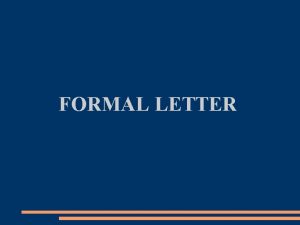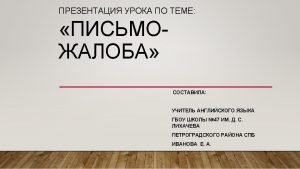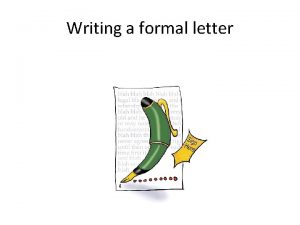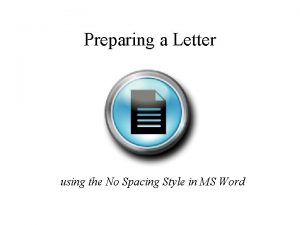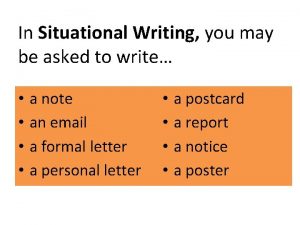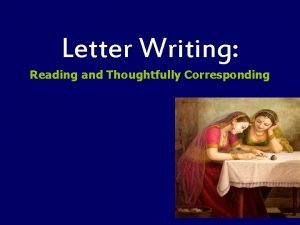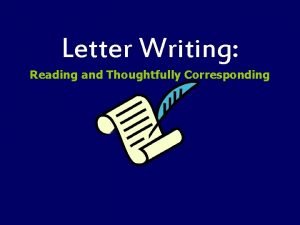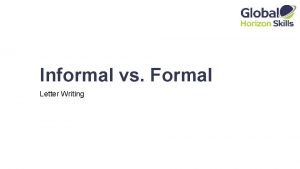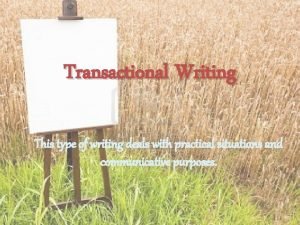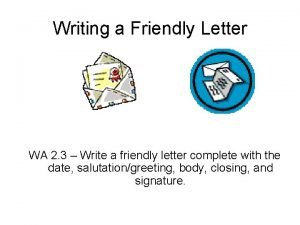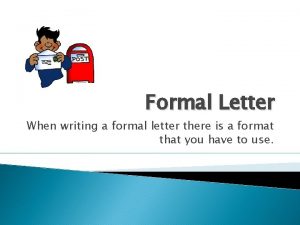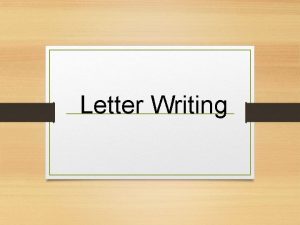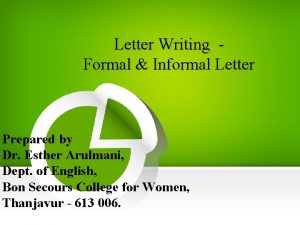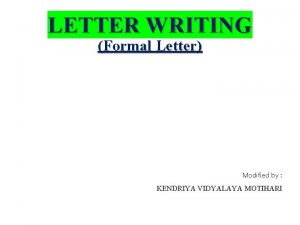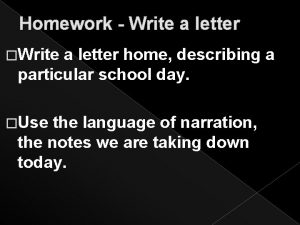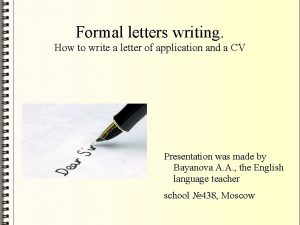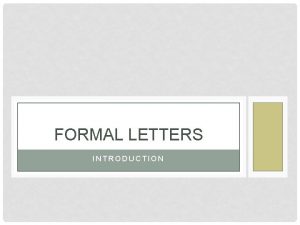Writing a Formal letter To write a letter














- Slides: 14

Writing a Formal letter To write a letter for planning permission.

Formal Letters The lay out of a formal letter

Address of the person to whom you are writing. This should be written on the left, starting below your address. The greeting. A) If you do not know the name use: Dear Sir/Madam, B) If you know the name use the title and the family name only: Dear Mr Green Your address This should be written in the top right-hand corner of the letter. Date To the right, a line below the address of the person to whom you are writing. The Main Text First paragraph - give a reason for writing; Keep it short, a couple of lines should be Signing off enough. A) If you do not know Middle Paragraph – the person use: Details. Yours Faithfully Last paragraph – B) If you know the What you would like person use: them to do as a result Yours Sincerely Your Name Write your name under your signature. of the letter. Thank them. First and surname.

Writing the letter

Task Each member of the group needs to write a letter to the local council asking for planning permission. The letter should include: • The proposed works (what you are intending to do. ) • How you are intending to do it. • Time Scale (how long it will take you. ) • How you are going to ensure you keep the original features.

Looking at different types of punctuation: 1. Full stops 2. Question marks. 3. Exclamation marks 4. Commas 5. Capital Letters 6. Paragraphs Other Good opening lines Good closing lines

Good Opening Lines: 1) With reference to your letter of 8 June, I. . . 2) I am writing to enquire about. . . 3) After having seen your advertisement in. . . , I would like. . . 4) After having received your address from. . . , I. . . 5) I received your address from. . . and would like. . . 6) We/I recently wrote to you about. . . 7) Thank you for your letter of 8 May. 8) Thank you for your letter regarding. . . 9) Thank you for your letter/e-mail about. . . 10) In reply to your letter of 8 May, . . . Back

Good Closing Lines: 1) If you require any further information, feel free to contact me. 2) I look forward to your reply. 3) I look forward to hearing from you. 4) I look forward to seeing you. 5) Please advise as necessary. 6) We look forward to a successful working relationship in the future. 7) Should you need any further information, please do not hesitate to contact me. 8) Once again, I apologies for any inconvenience. 9) We hope that we may continue to rely on your valued custom. 10) I would appreciate your immediate attention to this matter. Back

Full Stops Full stops do several jobs. They are the strongest punctuation mark, making the most definite pause. They are used at the end of all sentences which are not questions or exclamations. Stop the everlasting sentence! This is a very long sentence which does not make any sense. Can you put it right? There should be five fill stops. He trudged wearily along the dusty road his feet hurt and his head throbbed there was not a soul in sight for miles and he wondered what to do next when he saw someone waving at him at the top of the hill it was a tall man in a large hat Back

Question Marks A question mark is used at the end of a sentence which asks a question. It is used instead of a full stop so the next word begins with a capital letter. When the word or words in the sentence actually form a question it is called a direct question. This sort of question expects an answer. Which is the best route to London? An indirect question is a sentence which does not ask a question but tells you what question was asked. It does not have a question mark. He asked which was the best route to London. A question can just be one word. Why? Who? How? When? What? Take care! If a sentence begins with one of these words it does not necessarily mean it is a question. Back

Exclamation Marks An exclamation mark is used at the end of a sentence or phrase to emphasize some special meaning within it. It can mark surprise, humour or joy. I don't believe it! Silly me! What a beautiful day! It can show fear, anger, pain and danger. Don't shoot! How dare you! Ouch! When someone is giving an order or shouting an exclamation mark is used. Stand up straight! Halt! Attention! Call the police! Don't use more than one exclamation mark at a time. Don't use them too often or they will lose their effect and make what you write boring to read. Back

Comma A comma is used to mark a brief pause, much shorter than a pause made by a full stop. It can be used to separate two words, or groups of words, in a sentence, in order to make the meaning clear. Commas are the most common punctuation mark, but you have to be careful how you use them. You can easily change the meaning of a sentence by moving a comma to a different place or taking to away all together. Lists When there is a list of words in a sentence, each word is separated from the next by a comma. Commas are not generally used with ‘and’. In a list ‘and’ tends to replace the comma. Long sentences Two or more simple sentences joined together by words like ‘but’, ‘or’, ‘nor’, ‘so’, ‘either’ and ‘neither’ are separated by a comma before the joining word. Back

Capital Letters A capital letter should always be used for: 1. 2. 3. 4. 5. The beginning of a sentence. People’s names. Names of places. Names of streets, roads and buildings. Titles of books, plays, songs, newspapers, films and poems. 6. Days of the week, months of the year and for special days. 7. Titles 8. Titles before names 9. The names of God, Jesus Christ and names relating to them. 10. The word ‘I’. 11. Begin Paragraphs/ start of a new line of an address. The old Lady went to bed Bert Doris Smith New York Mount Everest Main Street The Mousetrap Monday December Christmas Prime Minister Lord Longford Our Father Allah I think I am poorly. 17 Main Street, London. Back

Paragraphs Long chunks of writing unbroken by paragraphs are very off putting to most readers. A paragraph is a set of sentences. There are no hard and fast rules about how many sentences should be in a paragraph. When there is a complete change of subject it is usually quite easy to tell that a new paragraph is needed. Back
 Rules of writing a letter
Rules of writing a letter Formal letter ending
Formal letter ending Letter of complaint
Letter of complaint Letter writing with subject
Letter writing with subject Casual writing pattern
Casual writing pattern Formal vs informal style
Formal vs informal style Technical writing and academic writing
Technical writing and academic writing Informal invitation
Informal invitation Spacing in business letter
Spacing in business letter Situational writing informal
Situational writing informal Objectives of letter writing
Objectives of letter writing Objective of letter writing
Objective of letter writing Formal letter writing format
Formal letter writing format Examples of transactional writing
Examples of transactional writing Complete the friendly letter
Complete the friendly letter
